|
FAQs about Sea Star Identification
7
Related Articles: Sea
Stars, Brittle Stars, Asterina Stars, An Introduction to the
Echinoderms: The Sea Stars, Sea Urchins, Sea Cucumbers and
More... By James W. Fatherree, M.Sc.
Related FAQs: Sea
Star ID 1, Sea Star ID 2,
Sea Star ID 3, Sea Star ID 4, Seastar ID 5, Seastar ID 6, Seastar ID 8, Seastar ID 9, & CC Star Identification,
Linckia Identification,
Sandsifting Star
ID, & Sea
Stars 1, Sea Stars 2, Sea Stars 3, Sea
Stars 4, Sea Stars 5, Brittle Stars, Seastar Selection, Seastar Compatibility, Seastar Systems, Seastar Behavior, Seastar Feeding, Seastar Reproduction, Seastar Disease, Asterina
Stars, Chocolate Chip Stars,
Crown of Thorns Stars,
Fromia Stars,
Linckia Stars, Linckia Stars 2, Sand-Sifting Stars,
|
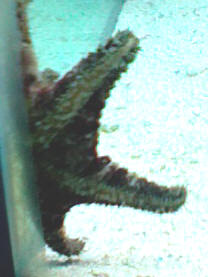
|
|
Need help identifying sea star -- 2/5/10
Hi! A teacher I work with bought a sea star at a local pet store
- they called it a "Purple Monster".
<Steph... we ask (where you found to write us) that people
limit their file sizes to a few hundred Kbytes (we have limited
webmail service space)... Yours is 11 some megs...>
We have searched by that moniker but found nothing. I searched
through all of your pictures and did not see anything that looked
quite right. I'm wondering if you can help us?
<I think this is a juvenile Choriaster granulatus... not
easily kept in captivity>
Here are two pictures I took of the sea star in question. It is
about 4 inches across. It was more vibrant in color when it was
first purchased about 3 months ago. We are wondering if it needs
a special diet that we could provide in the tank.
<Dead animals...>
Any help would be greatly appreciated!
Thanks so much!
Stephanie Nelson
<Welcome! Bob Fenner><<Actually, I defer to
LynnZ's ID below>>
Need Help Identifying Sea Star: Asterodiscides spp. --
2/5/10
Hi!
<Hello Stephanie, Lynn here today!>
A teacher I work with bought a sea star at a local pet store -
they called it a "Purple Monster".
<Heee! I guess it's related to the Purple People
Eater!>
We have searched by that moniker but found nothing.
<It happens all the time. That's the problem with common
names; they're not specific to one particular
organism.>
I searched through all of your pictures and did not see anything
that looked quite right. I'm wondering if you can help
us?
<I'll sure try! It appears to be a star in the genus
Asterodiscides, possibly an Indo-Pacific/Hawaiian species called
Asterodiscides tuberculosus (aka the 'toenail star').
Unfortunately, I can't find photos representing every species
in the genus, so the ID is only tentative. The single photo I did
find that seems to be a perfect match is located in a book by
John P. Hoover, titled Hawai'i's Sea Creatures - A Guide
to Hawai'i's Marine Invertebrates, copyright 1998, pg.
293. The book gives a brief description, stating that it's a
'shallow-water' star and that 'divers occasionally
see it at about 100 ft. on coarse sand or hard substrate adjacent
to sand'. Size is listed as 'to at least 7 in.
diameter'.>
Here are two pictures I took of the sea star in question.
<Nice, thank you!>
It is about 4 inches across. It was more vibrant in color when it
was first purchased about 3 months ago. We are wondering if it
needs a special diet that we could provide in the tank. Any help
would be greatly appreciated!
<The only diet-related information I was able to find
regarding any star in the genus was that the species
Asterodiscides truncatus feeds on sponges and algae. Most stars
are predators and scavengers but there are some that feed on
detritus and algae. I'd go with Bob's general
recommendations for feeding stars at the bottom of this link:
http://www.wetwebmedia.com/seastars2.htm
Here's a good photo of Asterodiscides truncatus:
http://www.poppe-images.com/?t=17&photoid=921879 >
Thanks so much!
<You're very welcome!>
Stephanie Nelson
<Take care, LynnZ>
|
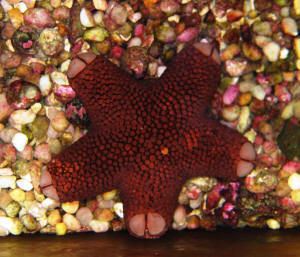 |
|
Starfish Identification 1/5/10
This little guy came with a piece of live rock about two years
ago. I saw him at the time and he was about the size of a nickel.
Well now he's much larger and the size of a silver dollar.
Any idea what kind of starfish this is? Is he a coral eater?
Thanks.
Spencer Hall
<Nope and nope. Perhaps with growth... Read here:
http://wetwebmedia.com/seastaridfaqs.htm
and the linked files in the series of FAQs above. Bob
Fenner>
|
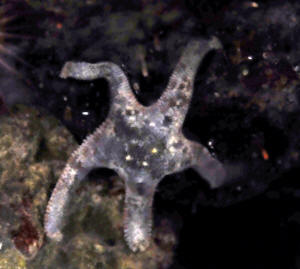 |
Wishing upon small white stars
12/22/09
I have a 110 gallon reef tank and have recently started to get it taken
over by what looks like small white starfish. Is this a bad thing and
if so how do I get rid of them?
Sean
<These are Asterina spp. starfish. They are not a problem as such,
but like so many other "pest" life forms (algae, snails,
bristleworms) a plague of them can be a symptom of an underlying
problems with the system. Excess
food in the system the gets converted into baby starfish by adult
starfish.
Limit the excess food, and the starfish population will be reined back.
As is often the case, the "fault, dear Brutus, lies not in our
stars, but in ourselves". See here:
http://www.wetwebmedia.com/asterinafaqs.htm
Cheers, Neale.>
|
Sea star identification -- 12/09/09
Good evening Crew,
<And you Steven>
I am trying to identify the species of starfish displayed in the
enclosed photo. It was sold to me as a "Hawaiian lace
starfish". I cannot find definitive information for that
common name, and I have yet to come across a photo of something
similar.
What is your expert opinion? It looks vaguely like a more
"knobby" Linckia, or like a less spiked Gomophia
egyptiaca.
<I do think this latter is what this is>
Thanks for you help and all the wonderful information you
provide,
Steven
<Welcome my friend. Bob Fenner>
|
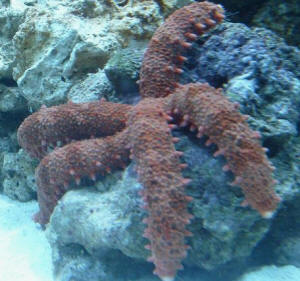 |
Re: Sea star identification. Gomophia
nutrition -- 12/09/09
Bob,
<Steven>
Now that we have established a likely species, do you have any
recommendations for diet of this magnificent star? Google does not
yield much assistance, recommending only "live food". The
star had no interest in the clam I offered it, but it is actively
foraging all over my 100lbs of live rock.
<Mmm, well, others have commented and I have seen these in the
wild apparently predating colonial tunicates, sponges, and other
permanently attached marine invertebrates... Perhaps in captivity
some sort of prepared foods ("Tetra Tips") would be
accepted; otherwise providing a good quantity of
"fresher" live rock may be the only alternative>
I just spoke with the retailer, who had the star in store for 6
months. It thrived in a 70 gallon tank with only live rock. He says
that he never once fed the star, but that it subsists off bacterial
film in the tank and on the rock. Would you agree with this
assertion?
<Don't know re the bacteria film itself... this may be
ingested along with whatever the animal is deriving nutrient from;
but I doubt it is the source itself>
That sounds more like the behavior of a Linckia. I would hate to
think I'm not providing adequate nutrition for this
creature.
Thanks again,
Steven
<You may be able to "tell" from taking measure, pix of
the star. They often "shrink" (really) if/when starved.
Bob Fenner> |
|
Unknown Asteroidean, ID, sel. 11/13/09
Hello WWM Crew,
<Scott>
I recently encountered a sea star at a reputable LFS that I am
hoping will be suitable for long term survival in my display. The
store manager told me that they found it in a live rock shipment
(most likely from the South Pacific) and they decided to see if
it would survive in one of their displays (a small mini reef
setup).
<Okay>
After four months at the LFS, the sea star seemed to be very
healthy and appeared to be regenerating previous damage to a
couple of its arms. My best guess at the time was that it was a
Linckia species and had a good chance of survival in my (four
years mature) 135 gallon SPS display. So in spite of concerns
about difficulty keeping this animal healthy long term, I decided
to give it my best efforts.
<Mmm, have taken a cursory look on WWM, and the Net... and I
swear I've seen this species somewhere... but don't think
it is of the genus Linckia... But the fact that it has prospered
in captive conditions bodes well>
After acclimation, quarantine and introduction to the display, I
had a chance to take the attached photo, with the hope you might
be able to help confirm the ID. My "novice" best guess
is Linckia multifora. Would you kindly advise your opinion on
this?
<Please try to match here:
http://wetwebmedia.com/seastars2.htm
or send along a link to a graphic that matches the body
conformation, colour, markings>
Apart from maintaining a healthy display for "grazing",
is there anything else you would do to insure this guy has the
best chance for long term survival, say for example some type of
target feeding?
<Experiment with various food stuffs... was this Echinoderm
fed anything specifically by the dealer?>
As always, I truly appreciate you folks and the service provided
by your invaluable website.
Scott
<Thank you, and thank you for sharing, contributing, being
part of it. Bob Fenner>
L. guildi does appear to be the closest match
11/13/09
Scotter, I've woken up a bit (finished my Java...) and I do
think you are right... re this ID... L. guildi does appear to be
the closest match. BobF
|
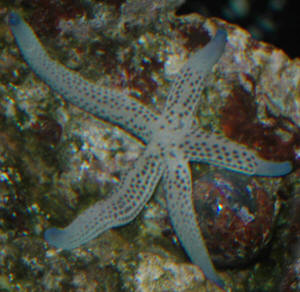 |
Small Stars/Starfish ID
10/27/09
Hi Crew,
<Sammy>
I have a few small starfish that I assume are Asterina. The arms are
symmetrical and not like the kind where some arms are longer than
others. I think I have a new one that is a hitchhiker since I did not
see him before.
The colors are the same as my others but he is quite a bit larger.
Would probably cover a nickle. The tips of the arms arch upwards and it
looks as if there is a V notch at the end.
<Have you Googled? Will get many hits/photos of Asterina
stars.>
I see him mostly on the rock and now he is on the back ( in an
Aquapod). Have not seen him on the glass yet. Just curious as to what
it might be. If I were to take a picture would you need to see the
underside?
<Likely an Asterina, there are several different species of these
starfish.
One of us could likely ID it without a bottom photo.>
Thanks,
<You're welcome. James (Salty Dog)>
Sam
|
ID; Pentagonaster - 05/03/09
Hey,
<Hello Mitchell.>
We brought home some live rock the other day and after about an
hour of it being in the tank a little starfish appeared (I've
attached the photo).
I've looked over all your information on starfish and still
can't find a photo to match it. Do you know what type of
starfish it is?
<Looks like a Pentagonaster duebeni.>
Also, for about an hour after we noticed it, it moved around the
rock it was on, then went to sleep on the back of the rock when
the lights went out. The next morning when the lights came on, he
was still on the back of the rock, but then he slowly moved down
and under the rock into a cave. Its been about 48hrs now and I
still haven't seen it. Did it hide to die?
<Can't tell from the information given in your email. If
the tank is well established this is not likely. Long term
survival is a different story. It belongs to the family
Goniasteridae and in general is not common in shallow
parts of the coral reefs. It feeds on sponges, bryozoans and sea
squirts, a diet which is hard to replicate in captivity unless
you have tremendous sponge growth in your tank or introduce new
rocks with sponges every few weeks.>
Thanks in advanced for your help,
Kind regards,
Mitchell.
<Welcome and good luck. Marco.>
|
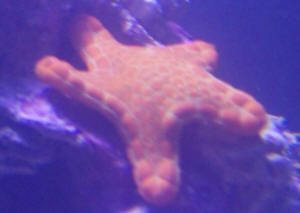 |
|
Re: Starfish ID 5/4/2009
Thanks for your reply :)
<Welcome.>
After doing some more research with the type you gave us, we
actually determined it is a Tosia queenslandensis as it was
collected in Far North Queensland, Australia.
<No... Beware, many online pictures of Tosia queenslandensis
are actually showing Pentagonaster duebeni. Tosia spp. have
shorter arms, look like larger, colourful Asterina stars, not
like the picture you sent. And
Pentagonaster occurs around Queensland, too, so it is well
possible it was collected there.>
He seems to be slowly devouring all the sponge in the tank, but I
still haven't seen him. Is there any way to get him to come
out during the day?
<If it does not come out at feeding time, you will hardly be
able to motivate the star to change its lifestyle.>
Thanks again for your help, Mitchell.
<No problem. Marco.>
|
|
Star fish... CC, reading, gen.
4/9/09
Hi.
<Saludo>
I have a starfish that I have not been able to identify. He is
shaped exactly like the cc star but is a beautiful red/ orange
color.
<Mmm, could still be a Protoreastor nodosus... Read here:
http://wetwebmedia.com/seastars2.htm >
If you can help me identify the guy I'd truly appreciate
it.
<A photo? Need this... >
Also, I have been reading through your site looking for more
information about the white patches that
have appeared on it's body. He/ she has been falling off the
glass lately and been unable to get back upright.
<... very bad>
It is eating frozen krill (which is all I've been able to
locate in our area to feed him/ her)
<Insufficient>
and is very active once I put it back in the upright position.
The tank which houses him is 80 gallons or so and all the levels
are good.
<?>
I typically give ¼ water change every other week
and also supplement trace elements weekly. I feel that I am an
experienced aquarist and have had little to no problems
maintaining aquariums for 18 years however this guy has me
stumped. Please help us.
Thanks
D
<Help yourself. Read:
http://wetwebmedia.com/chocchipstars.htm
and the linked files above. Bob Fenner>
Re: star fish, ID plus, P. lincki 4/10/09
Here's a pic of the star fish in question.
Water conditions in 80 gallon tank
Salinity 1.025
Nitrite 0
Nitrate 10
Ammonia 0
PH 8.2
Temp 76
Feeding him 3 times a week the krill and sea veggies.
Thanks again for all your help
<Oh! Another of the same genus... Is where you were referred
previously to read. Go there. BobF>
|
 |
|
Unknown Sea Star 3/10/09 I have had this
critter in my reef setup for two months now. I have been noticing
some interesting things happening that has led me to believe him
to be not reef safe. As soon as the lights go out he seems to go
after my two very large turbo snails and my electric blue hermit
crab, without luck due to their size. I caught him this morning
with one of my nice new fancy conch snails in his mouth. I pull
him out of the tank (pulling the snail with him) and banished him
to the sump until I can find him a new home. Any ideas what this
guy is? I was told he is a reef safe sand sifter. Thoughts?
<Mmm... is a sand sifter... looks like a juvenile Archaster
typicus... is NOT "reef safe", but a consumer of most
all small in-fauna (and above) vagile invertebrates. Bob
Fenner>
|
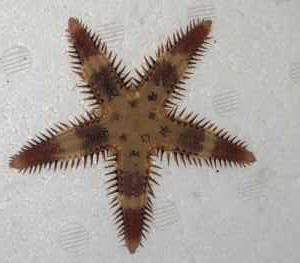 |
Sea Star ID 1/31/09 Hi!
<Hello> I'm a biologist working on asexual sea stars
<Interesting.> and I'm curious about the little tan/white
hitchhikers so common in aquaria. Specifically, I am trying to track
down where they are coming from as I am convinced that they are an
undescribed species. I have been working with these animals for 5 years
and am fairly certain they belong to the genus Aquilonastra (its a new
genus- 2004), but having gone through the diagnostic characters for all
the species yet described, nothing matches. I also suspect that there
are several undescribed species in aquaria around the world from
examining photographs on-line. New species from the wild are being
described every year. Obviously they are hitchhikers on live rock, but
my question is where is that live rock coming from? The Philippines?
Fiji? Tahiti? My local retail supplier cannot say and will not give me
his wholesale supplier's contact information. <By your short
description, my first guess would be Asterina stars. I can tell you
what I know about them if that is indeed what you are tracking down.
Class: Asteroidea Order: Spinulosida Asterina starfish, commonly known
as Fiji starfish are generally dime sized or smaller with a large body,
irregular arm length, and an irregular number of arms. They tend to
hide among corals and in the crevices of the live rock during the day.
This type of starfish has been known to eat coralline algae and some
corals; specifically Acropora, xenia, green star polyps, Zoanthids, and
several types of soft leather corals. These starfish divide across the
main body with two or three legs of varying lengths and multiply
rapidly. Fiji is one area where they are found, Bob may input other
areas. Take a look at the photos in this link for comparison.
http://www.wetwebmedia.com/asterinafaqs.htm> Any help would be most
appreciated! <You're welcome. James (Salty Dog)>
Re: Sea Star ID 1/31/09
Thank you James! <You're welcome.> I got interested in them
as I had a reef tank and got curious. I am now in the process of
publishing several papers on the factors that control their
reproduction. <Interesting. Do keep us posted.> I never had any
problems with them eating corals- not even the coralline algae and they
seemed to eat only the diatoms and green algae on the coral substrate
and glass walls of the aquarium. <I'm sure not all species eat
corals.> There are about a dozen described species of asexual
Asterina stars from the Indo-Pacific, but none described from East of
Palau/New Guinea. So I'm thinking there are likely many more
species out there. <Yes.> If some of these animals are known from
Fiji, I would very much like to get my hands on some but they have to
be from a known location. The animals that I have been using came from
the university aquaria and the local reef tank supplier. I would like
to be able to compare the two stars to see if they are the same. Then
at least I'll know where they come from! But I would need to be
able to talk with a supplier- and maybe their supplier- to get this
information. Might anyone you know be able to help? <I'm sure
Bob has many contacts, he may input/help here.> I really do
appreciate the information you have already shared. Thank you!
<You're welcome, and do share your progress with us. James
(Salty Dog)> Ken
White starfish with some grey on
it's back, 12/02/08 I have noticed a number of small white
starfish with shades of grey on their backs in my tank. These are
hitchers for live rock. My question is two pronged: Are they harmful to
my corals (Nano coral, polyp coral and star polyp coral)? <No, most
likely beneficial detritivores.> What type of starfish are they?
<Most likely either of the Class Ophiuroidea, or Asterina. Either
way they are beneficial and pretty cool.> I can attempt to download
a pic, but they are so small they are mostly blurry. <Most likely
not necessary, look on the web for pictures of these to see which one
fits what you have,> Thanks <Welcome>
<Chris>
Star Identification: Possible Oreaster sp. --
10/29/08 Good morning, <Hi Janet, Lynn here this
morning.> This star climbed out of a rather deep hole in a new
rock I just purchased. <Wow!> Can you tell me what type of
star it is so I can look up information on how to take care of him?
<It could be a species in the genus Oreaster. Unfortunately, I
can't quite see enough detail in the photos to be able to
narrow it down further. Please see the center photo at the top of
the following link (as well as related info there). The specimen
shown appears lighter than the one you have, but color can vary:
http://www.wetwebmedia.com/seastars.htm > I¹m new to
all of this (cycled my 75 gallon FOWLR last month, all is well!)
and want to keep it healthy. <Sounds like you're well on
your way!> Thanks so much, Janet
<You're very welcome. Take care, -Lynn> |
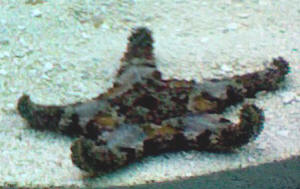  |
|
|

